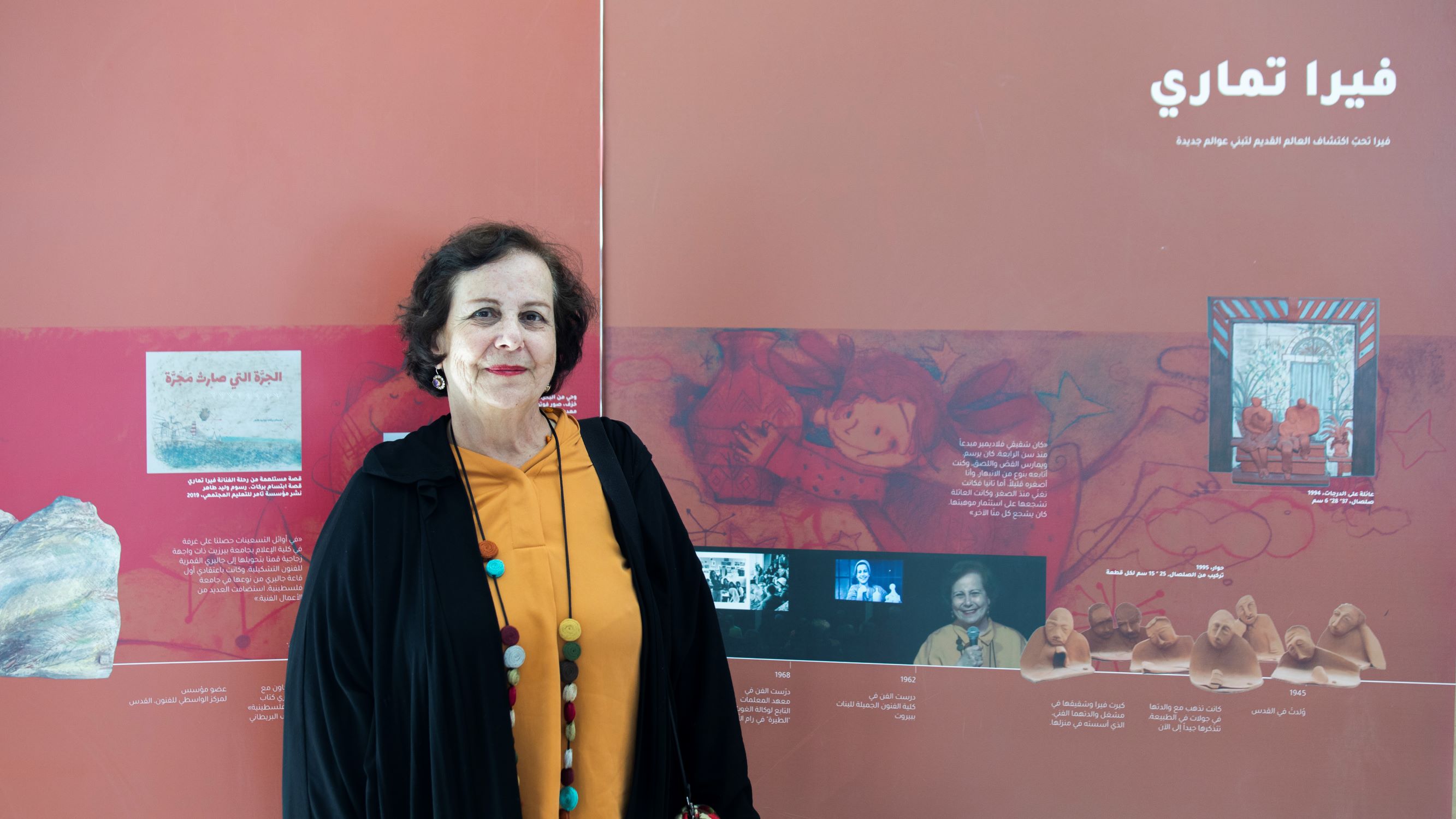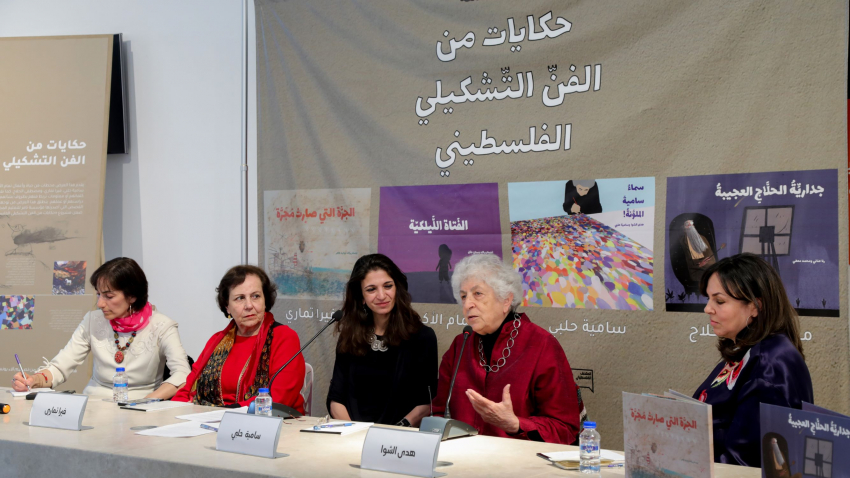

On Wednesday, 17 April 2019, the Tamer Institute for Community Education concluded the “Tales from Palestinian Art” project with the launch of four illustrated books that introduce a group of pioneering Palestinian visual artists. The event was organised in collaboration with the Palestinian Museum and was attended by the culture minister, Dr. Atef Abu Saif.
The project was supported by the A.M. Qattan Foundation through the ‘Visual Arts: A Flourishing Field’ Project, funded by Sweden.
The four books included: “Samia’s Colourful Sky”, inspired by the life of Samia Halaby, written by Huda al-Shawwa and designed by Samia Halaby; “The Urn that Turned Into a Galaxy”, inspired by the life of Vera Tamari, written by Ibtisam Barakat and illustrated by Walid Taher; “The Purple Girl”, inspired by the life of Tamam al-Akhal, written by Ibtisam Barakat and illustrated by Sinan al-Hallaq; and “The Fantastical Mural of al-Hallaj”, inspired by the life of Mustafa al-Hallaj, written by Rana Anani and illustrated by Mohammad Mo’ti.
The launch was attended by the artists Samia Halaby and Vera Tamami, and the writers Ibtisam Barakat and Huda al-Shawwa. The artist Tamam al-Akhal was refused entry to Palestine, so was unable to attend. The launch included a discussion with the artists and writers who were present, followed by a book signing.
The books, some of which include educational exercises, aim to enhance the visual literacy of children and adults alike, as well as to introduce and celebrate Palestinian artists and their Arab and international achievements.
The launch was preceded by a family-oriented event (a family day), attended by more than 500 people, mostly children and their parents, in addition to a number of artists and professionals from different governorates.
The day also included an exhibition curated by the artist and curator Alaa’ Younis that focused on the histories of the four artists. A number of workshops and interactive activities, designed by Aya Younis, a children’s educator and specialist based at The Children’s Museum in Amman, Jordan, and including pottery, stamp-making, collage and drawing informed by the artists’ artworks, also accompanied the exhibition. The artists Samia Halaby and Vera Tamari, and the writers Huda al-Shawwa and Ibtisam Barakat participated in these activities.
Commenting on this experience, Vera Tamari said: “This project is very important. For the first time, I experience an initiative in Palestine through which there is a direct interaction with the artists to produce stories focusing on parts of the artists’ lives, with the aim of introducing them to children. This could be the first time that children hear our names as artists, due to how art education in our schools stipulates a sort of restraint on how children can express themselves, while the existence of these stories, and the accompanying activities, introduce children to the artists’ multiple materials and experiences in a different and beautiful way.”
Vera Tamari also commented on the story about her life and her artistic experience, “This story is both realistic and fictional. I collaborated with Ibtisam Barakat during the writing stage to produce a text that is interesting for children, and that deals with one side of my artistic experience, especially the period during which I was introduced to clay. When I was a child, I visited the village of Sinjel and met the women who made pottery in the village, which is where I discovered this material and this type of art.”
For her part, Samia Halaby commented, “I was thrilled to learn about the project, and that Palestinians and other Arabs produced the texts and illustrations of the stories. I also appreciated the research undertaken by Huda al-Shawwa, which showed me, during the writing stage, that she is familiar with the nature of my work. Her idea of writing about my studio window overlooking the street also illustrates the relationship between abstraction, nature, the individual and her life, which is an important concept to convey to children through this story.”
Samia Halaby, commenting on the workshop that she conducted with the children during the family day, said: “Through the story, children comfortably contemplate life, through their own perspective, without orders and conditions. I noticed that during the workshop, children were free to do as they please; nothing prevented them from creating an abstract artwork, or from using rhythms and movement to express themselves. They also learned how to see things from a broad perspective, instead of thinking about them from a one-sided point of view. Children felt that I was with them in the same place and on the same table, working together on the same level, and what was beautiful about our presence with them is that they felt that one day they could also think and produce like us.”
“Tamer’s experience in story production is at the heart of our project’s interests and priorities, because producing child and youth-oriented educational resources with high-quality literary and visual content about the different arts has an important role in creating a critical visual culture. It also presents children and youth with inspiring models that are absent from the Palestinian curricula that is taught in schools,” commented Yara Odeh, the “Visual Arts: A Flourishing Field” (VAFF) Project Manager.
“The A.M. Qattan Foundation highly appreciates the role Samia Halaby, Vera Tamari and Tamam al-Akhal played in developing the educational and visual content of these stories, in significant collaboration with the Tamer Institute and the authors and illustrators of the stories. This reflects the artists’ keen interest in educating the younger generation about the history of Palestinian art,” added Yara Odeh.
The exhibition is expected to travel to Hebron, Jerusalem, Gaza, Haifa and Majdal Shams in the occupied Syrian Golan Heights, in collaboration with a number of institutions and cultural centres in each city. The series of books will also be distributed to all the community libraries all over Palestine. The project seeks to reach approximately 5,000 children across historic Palestine through the activities that accompany the launches of the stories planned to take place during this month. These include various interactive exercises and additional activities which willl focus on the artists and his or her style, thus enabling children to interact and be immersed in the stories and the various artistic styles.
In addition to producing the four books, the project also contributed to the translation and printing of a book by Heather Alexander entitled “The World’s Greatest Paintings and Sculptures”, which introduces children to the world of art. The book was translated with the aim of making educational resources about art from around the world available in Arabic.
The project has also included training programs facilitated by specialists with exceptional literary and artistic experiences. These have benefited 80 Palestinian students, artists, and professionals from the art sector in the West Bank, Gaza Strip and the diaspora. Tamer Institute also organised a training workshop on story illustration and 2D and 3D drawing, led by the illustrator Amal Karzai via Skype.
Additionally, the Argentinian illustrator Isol, winner of the Astrid Lindgren Memorial Award, ran an illustration workshop, while the renowned Swedish writer and illustrator, Anna Höglund, led a training programme focusing on the production of illustrated stories.
This project also bolstered the sustainability of the Tamer Institute for Community Education through developing its distribution, publishing and promotion capabilities. The Institute’s staff participated in a workshop on new ways of marketing books and developing marketing strategies. The institute’s website has also been developed to add an online bookstore feature.

